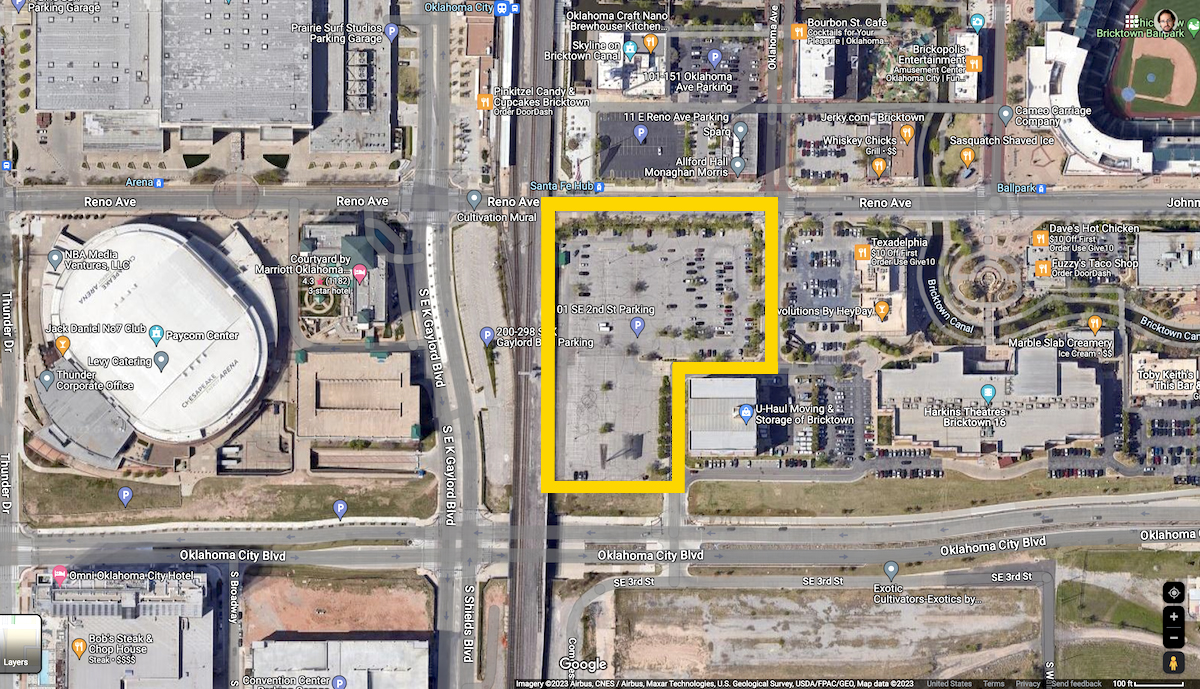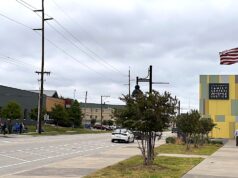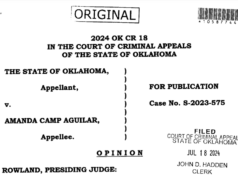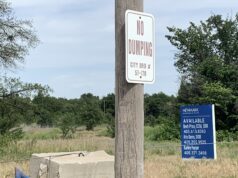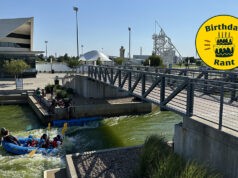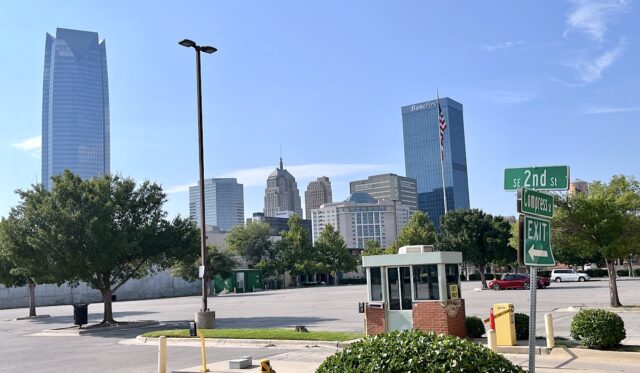

The Oklahoma City Planning Commission this afternoon approved part of a plan to construct the largest tower in the United States, while also approving controversial plans for a new Oklahoma County Jail to be located near the city’s southeast boundary with Del City.
Since Matteson Capital’s January announcement that its Boardwalk at Bricktown project would be expanded from its original proposals to include a 1,907-foot skyscraper, the public has been alternately bemused and captivated by the idea. The building, called Legends Tower, would be the tallest in the country and one of the tallest in the world if it is built.
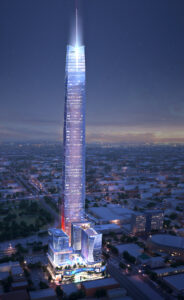
But the project remains complicated and includes other towers that must be built and leased before construction would begin on Legends Tower. While the OKC Planning Commission voted 7-2 to advance the project Thursday for consideration by the City Council in six weeks, the commission did not vote on proposed electronic signage that would almost completely cover every side of the building and be viewable from miles away. Developers will need to complete a separate process for that part of the project, including later Planning Commission and City Council approval.
Mark Zitzow, an urban planner for Johnson and Associates, said the permit request considered Thursday is much like that of other downtown projects.
“This SPUD is identical to one approved several years ago, except for building height and signage,” Zitzow told commissioners. “It’s not different than any other downtown properties which have no cap on height.”
The project would include three towers, architect Rob Budetti of A.O. told commissioners. The Boardwalk project proposes hotels, retail space, restaurants and apartments. Many of the rental units would be luxurious in nature, although the project’s prior iteration that was proposed for approval of a TIF district promised some residential floors would be dedicated to transitional housing for those trying to escape homelessness. The project would also include above-ground parking and a three-level underground parking garage.
Planning Commission Chairman Camal Pennington asked Budetti how the tallest part of the project would stand up against the potential threat of severe storms, such as tornadoes. Budetti said those issues are taken into account during the design phase.
RELATED
With nebulous nonprofit proposed to provide services, Bricktown apartments’ TIF vote looms by Matt Patterson
“The way it works with these super-tall towers, which you have seen all over the world in high wind and earthquake zones, is there are several firms that specialize in analyzing the forces that are imposed by a tornado or any wind event and they are able to calculate those forces the same we calculate forces from seismic activity,” Budetti said.
Budetti said the project will also help fill in a gap of needed hotel room inventory in OKC.
“I believe when the project started there was a study done from a hotel standpoint, and it said you guys were short 3,500 rooms in OKC,” BUdetti said. “And on the residential side, as they start leasing the first two towers, the third tower comes in. We have seen demand. There is a little bit of a ‘build it and they will come’ (philosophy).”
Budetti said the smaller towers would take about 24 to 30 months to build, with the Legends Tower taking an additional 12 to 18 months beyond that point. But many observers feel uncertainty about whether Legends Tower will ever be built.
“I think the timing of the tall tower is still to be determined, whether it is built at the same time or as a phased approach,” Budetti said. “That will come from financing conditions.”
Pennington expressed concern about the project’s massive video signage component, which would include massive video displays around all sides of the building, according to renderings. The look of those renderings could conjure images of Times Square in New York or the Las Vegas Strip.
“I think it’s really important when we talk about investment of this scale in our city, we have the extra effort so that we end up with a good product,” Pennington told fellow commissioners. “At the end of the day, even if we approved this with the existing language, there are no signs unless it comes back to us or unless the City Council makes a decision, which they have a right to do even with this language. They may be OK with this. I’m not. I’ll tell you right now, what I see on signage right now, I can’t vote for. I think that’s probably shared by most of us at this point, but I’m willing to give the applicant the opportunity to come back with something.”
Plans for the project were announced last year and initially included an Arizona nonprofit providing job training and financial counseling to low-income residents. It’s unclear if that portion is still part of the development and whether the nonprofit will be involved.
New Oklahoma County Jail site plan moves forward
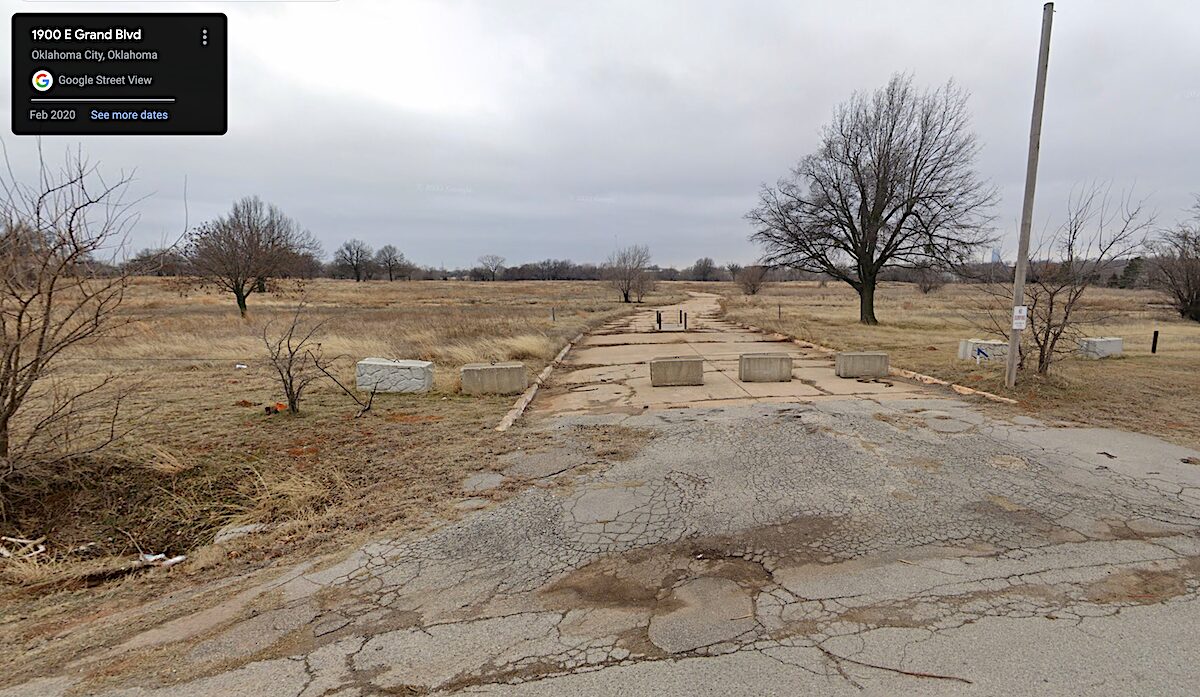
After two votes, the first of which failed to reach the required five affirmative vote threshold, the OKC Planning Commission recommended City Council approval of a special use permit for the proposed Oklahoma County Jail site at 1901 E. Grand Blvd., just feet away from the Del City city limits.
The final votes came after the commission spent considerable time discussing issues that are not typically within their purview, including when and where detainees at the jail could be released and where they could be held until that release time. Those issues are almost exclusively the realm of Oklahoma County commissioners, Oklahoma County judges and jail staff.
The first vote closed 4-3, resulting in the special permit request falling short of the required five-vote threshold. However, after technical evaluations were added to construct a 12-foot barbed wire chain link fence, limitations on releasing detainees directly from the site, and prohibiting outdoor loudspeaker use on the jail site, the special permit recommendation to the City Council passed 5-2. It will now head to the OKC City Council in six weeks for final approval and possible amendments.
Attorney David Box, who presented the jail project on behalf of developer Garrett and Company Resources, said earlier in the meeting the proposed jail site is ideal.
RELATED
Despite Del City’s lawsuit threat, Grand Boulevard site picked for new Oklahoma County Jail by Matt Patterson
“The site is already zoned,” Box told commissioners. “In fact, it’s zoned I-3. I-3 represents the most intense zoning district that we as a city have. I-3 is defined as a district intended to provide locations for uses that may generate relatively high levels of noise, vibration, smoke, dust, odor or light. We don’t anticipate those issues with this facility. The point is the city has created a zoning district to locate uses that are otherwise difficult to place anywhere else within the city.”
Box also pointed out the current jail in downtown OKC is less than 1,400 feet from John Rex Elementary School. Opponents from the Crooked Oak School District have said the new jail site is too close to their school. Box said the proposed jail site would be about 2,700 feet from Crooked Oak High School, further away than the current arrangement.
That did little to assuage the fears of Del City residents and officials who have been vocal in their opposition to the proposed site since late last year. Del City Mayor Floyd Eason said the jail plans don’t take into account surrounding areas.
“I look at all these diagrams, and I just can’t keep my mouth shut,” Eason said. “All of their drawings end at Bryant Avenue. The world doesn’t end at Bryant. Across from Bryant, there are a thousand homes within a mile of this jail location. The developers end their world at Bryant, but that’s where our world begins. We’re looking out for the citizens that live in that area. That’s all we’re trying to do.”
During the public comments portion of the meeting, Del City native and municipal Judge Blaine Nice said the comparisons to John Rex Elementary are irrelevant.
“Mr. Box as always does a fine job making a presentation,” Nice said. “The zoning presentation he makes he is exactly right. The zoning may fit this, but this isn’t about zoning. It is about special use. He talks about, ‘Well, we have housing down by the current jail and we have a school down there,’ but it came to that of its own volition. The people of Del City don’t have that choice. They’re already there, and it’s coming to them.”
Criminal justice reform advocate Jess Eddy also spoke out against the proposed jail site. Eddy previously lobbied county commissioners to locate the jail on its current site in downtown Oklahoma City. Eddy said the proposed site would not offer the same proximity to services recently released detainees may need.
“Removing incarcerated people, some of the most vulnerable people in our community, from the center of our community in close proximity to all of those services is frankly a bad decision, and it is a decision that has not been accompanied with the appropriate levels of process, consideration and community involvement,” Eddy said.
Pennington said he opposes the special use permit for many of the same reasons. He voted against the recommendation twice Thursday.
“I’m against this special permit because I’m for putting the public first,” he said. “I think a more robust and transparent public process should have been done and a great collaboration between our city and county leaders should have been done prior to this application.”
But fellow commissioner Rusty LaForge said his initial concerns about the site had been satisfied.
“The experts have looked, and they have found this is the highest-rated spot,” LaForge said. “Nobody wants it anywhere. OKC is in the center of the county, and this is roughly in the center of the city. There is going to be pros and cons and negatives, but the fact is this came out as the highest-rated spot, and we have to get moving. We have to build a new county jail.”
County officials are under a deadline crunch because of the use of American Rescue Plan Act funds for the new jail’s construction. Under federal law, those ARPA funds must be encumbered by the end of 2024 and spent by the end of 2026.
The City of Del City said earlier this year that it would sue Oklahoma County to block the jail from being located near its city limits. However, with the proposed site not even located in Del City, it is unclear if that effort will move forward.
Alley’s End project set for public hearing
Alley’s End, a proposed $57 million affordable housing project in downtown OKC, will be discussed and voted on during the OKC City Council’s April 23 meeting.
The project is funded through ARPA, private financing and $2 million in community development incentives through the city.
The project would be built at Northeast Fourth Street and Gaylord Boulevard and would include 214 affordable housing units. The effort is part of growing attention toward the city and state’s growing affordable housing problem.
The project would include studio apartments with rents starting at $450 and going up to $850. It would also include one-, two- and three-bedroom units with the top-line rent for a three-bedroom apartment set at $1,400 per month.
Ward 6 Councilwoman JoBeth Hamon said during the OKC City Council’s meeting Tuesday that she hopes the project will serve those most in need.
“I spoke with a woman last week who is elderly and who works at Taco Bell for about 20 hours a week, and she doesn’t have any family that she’s living with,” Hamon told fellow city councilors. “She’s on her own. So, the ability to find things in an affordable and attainable range that are in good shape and are acceptable is very rare, so I am excited to see this opportunity for folks and happy to see something happen on this lot.”
Ward 2 Councilman James Cooper said Oklahoma’s reputation as a low cost-of-living state has faded in recent years, making the need for affordable housing more acute.
“All of my life for all of those 42 years until just about the last 10, the narrative has been we are a low cost-of-living state, but it has devolved into myth,” he said. “It is no longer true. We have a housing crisis. And that is hard for a lot of people to hear.”
Sunset amphitheater project rejected by council Tuesday
A proposed $70 million, 12,000-seat amphitheater development near Interstate 40 and the Kilpatrick Turnpike will not be built there after the OKC City Council denied the developer’s application for the project with a 7-2 vote. Only Ward 1 Councilman Bradley Carter and Ward 8 Councilman Mark Stonecipher voted for the project.
The proposal was brought forward by Notes Live, an entertainment event company headquartered in Colorado Springs. The company was recently approved for a similar project in Broken Arrow.
The OKC proposal failed in large part owing to vocal and organized opposition from homeowners in the surrounding area, which borders Yukon. Many came to speak at Tuesday’s council meeting.
Phillip Cox, 36, said he first moved into his current neighborhood near the proposed project when he was 6 years old.
“After going to college, I came back to the area,” he said. “Putting in this amphitheater jeopardizes everything we’ve built.”
Don Bryson has lived in his home for 20 years and said he feared the development would create hardship.
“One day, I may want to sell my house, and because of the negativity brought to the area by the amphitheater, my home might sell for less than fair market value, and that is unacceptable,” he said.
Lt. Gov. Matt Pinnell had also promoted the project, which developers said would now seek a different location.









